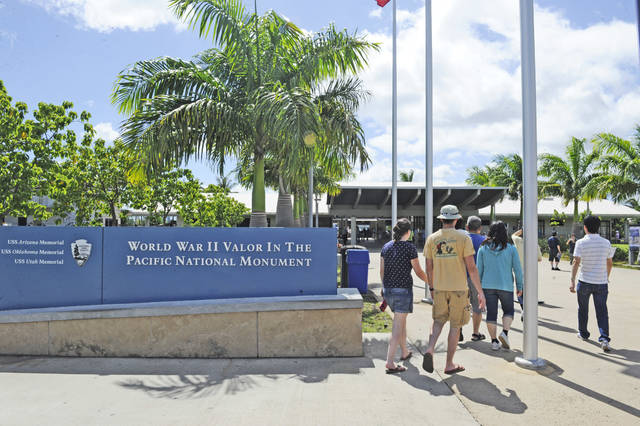USS Arizona Memorial site gets name change

BRUCE ASATO / 2014
The rather lengthy and much-encompassing World War II Valor in the Pacific National Monument designation applied by President George W. Bush in 2008 was recently removed by Congress. The new official name is the Pearl Harbor National Memorial.
The USS Arizona Memorial has become part of a national memorial — again.
The rather lengthy and much-encompassing World War II Valor in the Pacific National Monument designation applied by President George W. Bush in 2008 was recently removed by Congress.
The new official name for the famous National Park Service unit, signed into law on Tuesday, is the Pearl Harbor National Memorial.
The sunken USS Arizona remains a grave for over 900 men who died in a fiery explosion on Dec. 7, 1941, during Japan’s surprise attack
“The park and its partners are universally delighted with the name change that was signed into law by the president this week,” said Superintendent Jacqueline Ashwell. “Our prior name was rather long and unwieldy and difficult to remember. Everyone still referred to us as ‘the USS Arizona Memorial’, even though we now protect and interpret additional memorials and several historic remnants of the attack on Oahu.”
The Arizona Memorial visitor center, the USS Utah and USS Oklahoma memorials, six chief petty officer bungalows on Ford Island and three pairs of mooring quays along historic Battleship Row will remain part of the Pearl Harbor National Memorial.
Don't miss out on what's happening!
Stay in touch with breaking news, as it happens, conveniently in your email inbox. It's FREE!
The new name “is easy to remember, immediately understandable, and is a name commensurate with the importance and reverence of the site,” Ashwell said. The park plans to announce next steps on the name change in early April, she said.
Before the Arizona Memorial was part of the World War II Valor in the Pacific National Monument, it was the USS Arizona National Memorial.
The new name reflects a desire to connect to a greater degree with the familiarity of “Pearl Harbor” history. The former Pacific Aviation Museum Pearl Harbor on Ford Island changed its name to Pearl Harbor Aviation Museum.
The legislation also changed the name of Honouliuli National Monument, which was created in 2015 and is also a unit of the park service, to Honouliuli National Historic Site.
Ashwell said the new name “makes it consistent with other Japanese American incarceration sites managed by the National Park Service, such as Manzanar National Historic Site in California and Minidoka National Historic Site in Idaho.”
The 2008 Valor in the Pacific proclamation by Bush lumped together the five sites on Oahu, three in Alaska associated with military action, and one in California, the Tule Lake Segregation Center where Japanese Americans were detained as the result of President Franklin Roosevelt’s Executive Order 9066.
“Many Americans valiantly supported the war effort even as they struggled for their own civil rights,” Bush’s proclamation for the monument stated.
But in practice, the designation became confusing. The park service mainly highlighted the Arizona Memorial on its Valor in the Pacific website.
The U.S. Fish and Wildlife Service manages the Alaskan Aleutian Islands sites, while the park service and Fish and Wildlife co-manage the Tule Lake unit.
Former U.S. Rep. Colleen Hanabusa of Hawaii, who sponsored a bill to make the name changes, previously said that Pacific Historic Parks, a nonprofit that aids the Arizona Memorial and other sites, related to her the complications of trying to raise money for Pearl Harbor under the name World War II Valor in the Pacific National Monument.
“What they have said is that a lot of fundraising has been difficult for Pearl Harbor,” Hanabusa said.
Instinctively, “a lot of us feel that a ‘monument’ must be a better designation. But in actuality, in terms of a (congressional) line item and things like that, it really is better to have your own historic site designation.”
The fundraising logic also applies to Honouliuli, the largest and longest-used confinement site during World War II, holding 400 internees who were mostly Japanese-Americans, as well as 4,000 prisoners of war.
As a national historic site, Honouliuli can receive greater benefit from Congress, said Hanabusa, whose grandfather was interned there. A monument “is kind of a unilateral act on the part of the president by proclamation,” she said. “Whereas when you designate a historic site, it is an act of Congress.”




